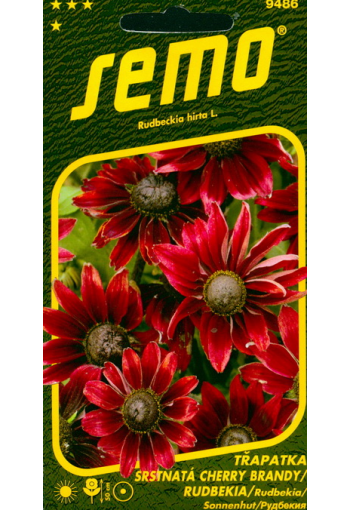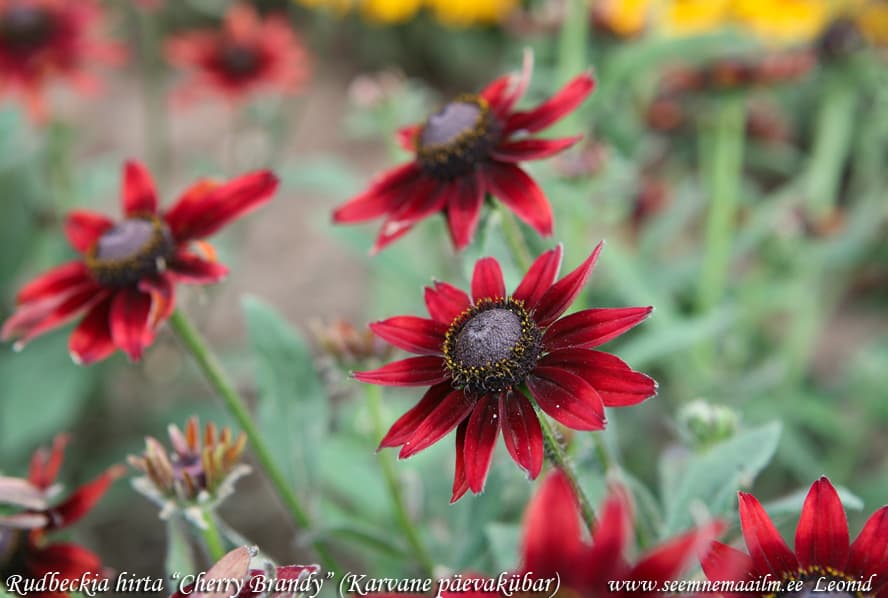The first rudbeckia with a rich red colour of inflorescences from seeds!
Plant height up to 50 cm. Flower diameter 10-11 cm. Inflorescences are large, cherry red. Blooms profusely and continuously from July to October.
Excellent in any corner of the garden: in the flower beds, in the border, in groups against the backdrop of the lawn. It blooms for a long time until the first frost, it is excellent in cutting.
Agrotechnics.
Prefers a sunny location and sufficiently fertilized fertile soils. Seeds are sown in March in seedling boxes, lightly sprinkled with earth.
At a soil temperature of +18°C shoots appear on 14-21 days.
Seedlings are planted in a permanent place after the end of spring frosts, maintaining a distance between plants of 25-30 cm.
Possible direct sowing in open ground in early May.
Hardy annual.
Flowers in: Summer to frost.
Germination: Experience.
Useful Aftercare: Easy.
Ideal for: Borders, Containers.
Height: 60 cm.
Description: following the 2002 success of Cherokee Sunset, Thompson & Morgan flower breeders are proud to present the first-ever red Rudbeckia from seed!
These robust plants have outstanding garden performance, producing a mass of attractive, cherry-coloured blooms all summer long - triumphing over heat, drought and poor soils!
Stunning when planted in drifts in borders or can be planted in large containers to create a feature plant on a patio or terrace.
Sowing Instructions: sow seed on the surface of good, free-draining, seed compost. Cover with a very fine sprinkling of compost or vermiculite.
Place container in a propagator or seal container inside a polythene bag and place at a temperature of +20+25°C until after germination which usually takes 7-21 days.
Do not exclude light, as this helps germination.
Growing Instructions: transplant seedlings when large enough to handle into trays or 7.5 cm pots.
Gradually acclimatise plants to cooler conditions for a few weeks before planting out after all risk of frost, 30 cm apart.
Black-eyed Susan, gloriosa daisy. Bot. syn.: Rudbeckia amplectens, Rudbeckia brittonii Small, Rudbeckia monticola Small, Rudbeckia serotina Nutt.
* Annual rudbeckias are ideal for pot culture.
On fine autumn days they will add a special shine to the sunny terrace, especially when most of the summer flowers have already faded, and on cloudy bad weather they will illuminate it with sunny bunnies as a greeting to the bygone summer.
In June, plant the seedlings in a permanent place. The distance between plants in the ground is about 30 cm; in a pot, depending on its size, place from three to five plants, but remember that over time, hairy rudbeckia forms a dense, wide bush.
The soil, as for all rudbeckias, should be quite light and nutritious. Do not forget to regularly water the plants in pots, and in the summer heat do not leave the pots in the sun.
Remove faded heads, leaving only one or two of them for seeds.
This rudbeckia does not tolerate frost well, so if there is a danger of frost, it is better to bring the pots indoors - this way you will prolong the flowering of this wonderful plant until late autumn.
Although rudbeckias can grow in any soil, still try to prepare suitable loose and nutritious soil for them by adding mature compost to the planting - a bucket per square meter. Add sand to clay soil to improve the structure. The soil under the plantings should not dry out, so in dry years, water the plants regularly.
Rudbeckias grow well in the sun, although they tolerate light shade. In the spring, before growth begins, feed the plants with a mixture of mineral fertilizers: 20 g per 1 m2.
It is advisable to mulch the soil under plantings with humus. At the beginning of flowering, the plants can be fed again with phosphorus-potassium fertilizer, which stimulates the formation of buds.












